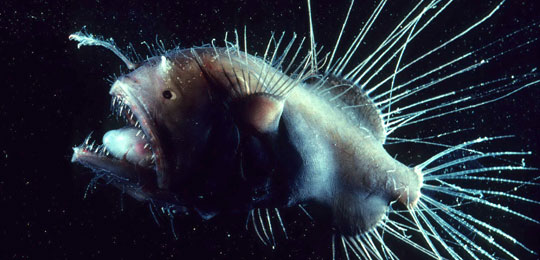
THE ANGLER—FISH.
IN our picture we have a view of a very strange fish. He does not look much like the fishes we catch in the ponds and brooks. His head, as you see, is large and flat, and he has a wide, gaping mouth, with rows of sharp-pointed teeth. His eyes, instead of being on each side of his head, are placed on the top. You will notice that the two side fins are different from those of a common fish. They seem to be large and strong, and stand out a little, like very short arms. By means of these fins, some of the fishes in this family can walk over wet ground nearly as well as four-footed animals. It would look strange, would it not, to see a fish walking on the land? Yet some kinds of fishes are so made that they can go on quite long journeys over hot and dusty roads, to get from one pond of water to another.
The angler is a very hungry fish, never seeming to have all it wants to eat; and the worst part of it is, it eats other fishes. It is not a swift swimmer, and so it would often go hungry, if it depended on its swiftness for catching the fish. The way it does get its food is truly wonderful. Many fishes have two fins on the back. But the angler has three spines in the place of the first fin. The first one of these spines has at its tip a oose, shining piece of skin. At its base, the bone that forms the spine grows in the shape of a ring.
Through this ring a short bone passes, fastening the spine to the rest of the bones of the head in such a way that the fish can freely move the spine in any direction. You can see just how this is done if you should drive a staple through the ring of an iron skewer into a board. You could move the skewer any way you pleased. Just in this way the spine is fastened to the angler's head. The other spines are fastened on in a very similar manner.
You can see them in the picture, between the eyes of the fish. What does he do with them? They are his bait.
As was said before, he cannot swim fast enough to catch the fishes; so he buries himself in the mud, leaving the spines on his head above the mire, and he waves them back and forth. Fishes are very curious creatures, and are always anxious to find out about anything shining in the water, as the boys who have fished with tackle having a spoon-shaped piece of polished metal fastened to it know very well. As the fishes see this shining bit of skin, flirting round, they rush up to find out what it is. Then the angler opens his wide, gaping mouth, and swallows the fish down.
He is such a greedy fellow that he sometimes swallows the cork floats on nets and lines. When he is caught in a net himself, lie does not seem to be disturbed by it; but turns round and eats his fellow-prisoners. He grows from three to five feet long. He is good for nothing, so far as his use to man is concerned. His flesh is not good for food, and his body contains very little oil.
W. E. L.
